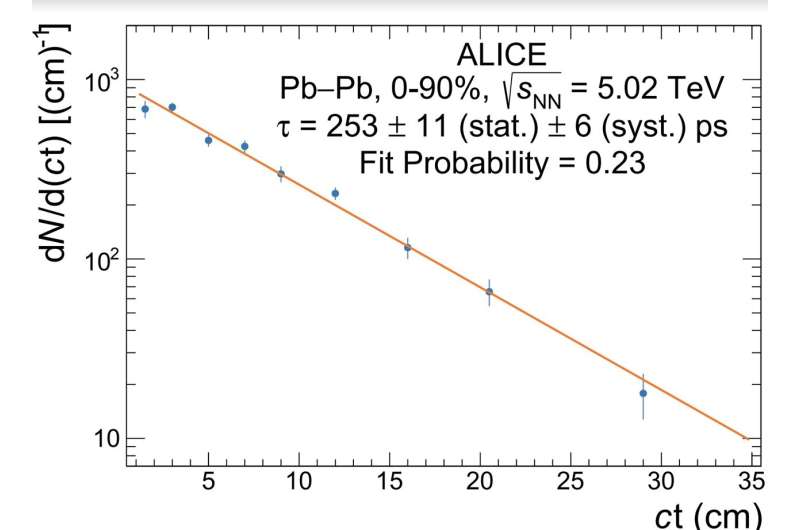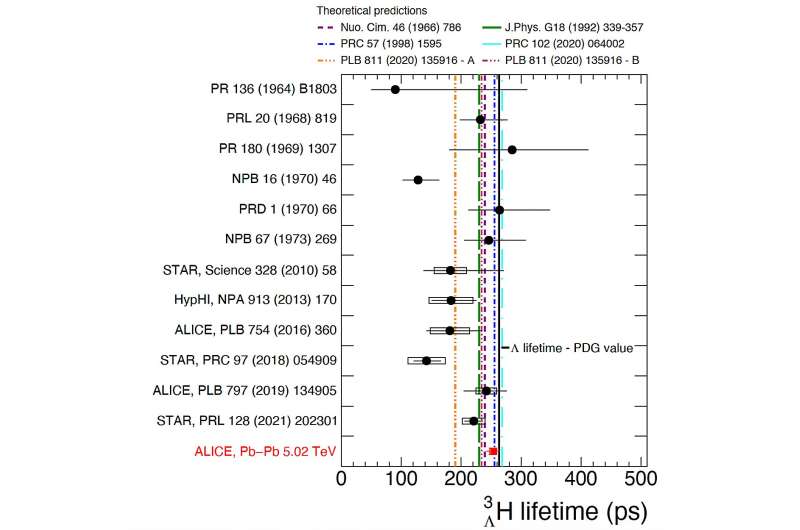September 29, 2023 feature
This article has been reviewed according to Science X's editorial process and policies. Editors have highlighted the following attributes while ensuring the content's credibility:
fact-checked
peer-reviewed publication
trusted source
proofread
A new highly precise measurement of the hypertriton lifetime

A hypertriton is a tritium nucleus in which a neutron is replaced by a so-called Lambda hyperon. This type of hypernucleus was first discovered in the 1950s has since been the key focus of numerous studies.
The ALICE collaboration, a large research group that studies the collisions of nuclei inside CERN's large hadron collider (LHC) in Switzerland, recently measured the lifetime of a hypertriton with remarkable precision. Their paper, published in Physical Review Letters, is a further step forward toward understanding the unique properties of these fascinating nuclear complexes.
"As the first and lightest hypernucleus (i.e., a nucleus that includes a baryon with at least one strange quark) ever identified, the hypertriton holds a special place in nuclear physics," Maximiliano Puccio, part of the ALICE collaboration, told Phys.org.
"While its initial discovery was in a stack of stripped emulsion exposed to cosmic rays, conventional hyper-nuclear experiments using kaon beams have found it challenging to study hypertritons. However, research over the past 20 years, especially with contributions from our colleagues at the RHIC collider, revealed that these rare bound states are created during heavy ion collisions."
While recent works by the ALICE collaboration and other large research efforts worldwide have made significant strides towards the understanding of hypertritons, many of their properties are yet to be ascertained. Specifically, many of the measurements gathered over the past few years come with considerable uncertainties and thus do not paint a reliable picture of their properties.
"Given that the hypertriton's lifetime and Λ separation energy play a pivotal role in refining Λ-nucleon interaction models, we wanted to do new measurements at the LHC as gaining insight into these Λ-nucleon interactions is crucial for understanding the properties of neutron stars," Puccio explained. "To do this, we used the largest antimatter and hypermatter factory in the world: the LHC."
The LHC is currently the largest and most powerful particle accelerator in the world, spanning over 27 km at a CERN underground facility beneath France and Switzerland. For approximately one month in every year that it collects data, the large particle accelerator collides lead (Pb) nuclei, and one in every few millions of these collisions results in the formation of a hypertriton or antihypertriton.

"During the last data-taking year of the LHC Run 2 (2018), we collected a data sample containing roughly 500 antihypertritons and 500 hypertritons decaying in a (anti)3He and a charged pion," Puccio said.
"In the large stack of the thousands of particles being produced in the Pb-Pb collisions, using the ALICE detector, we could identify cleanly the (anti)3He by looking at the specific ionization in the ALICE Time Projection Chamber. Then, we associate all the pion tracks to the (anti)3He track reconstructing candidate decay vertex."
Ultimately, the ALICE collaboration analyzed data collected by the LHC in 2018 using state-of-the-art computational techniques for binary classification, namely boosted decision tree models. These models allowed them to detect hypertriton candidates among the signals and background noise recorded in the accelerator.
"This last step and the extensive data sample acquired in 2018 made it possible to get the most precise measurements of the hypertriton lifetime and hypertriton Λ separation energy," Puccio said. "Also, we could measure these quantities for matter and antimatter separately and compare them. As expected from the CPT invariance of the Standard Model of particle physics, the properties of hypertritons and antihypertritons are the same."
The recent work by the ALICE collaboration could have valuable implications for the study and understanding of hypertritons. Specifically, the team was able to collected a single measurement of hypertriton lifetime that is just as precise as the world average of all the previous measurements.
"With our new measurement of the hypertriton Lambda separation energy, we manage to provide a measurement with an uncertainty better than 100 keV using an experiment designed to analyze the most energetic particle collisions in the world, happening now at 13.6 TeV in pp collisions," Puccio said.
Reaching such precision is not, however, an exercise in style: the natural statistical fluctuations of the previous measurement lead to the creation of a "hypertriton puzzle in hyper nuclear physics. Different measurements from different experiments were suggesting two different scenarios for the hypertriton structure, either extremely loosely bound or more tightly bound. Our measurements are consistent with a loosely bound hypertriton and can be used to constrain the hyperon-nucleon interaction models."
The recent measurements gathered by Puccio and the rest of the ALICE collaboration appear to be aligned with theoretical predictions based on effective field theories, which suggest that a hypertriton's structure is that of a weakly bound system. The research group plans to continue analyzing data collected at the LHC, in the hope of probing the properties of hypertritons with increasingly high precision.
"The LHC Run 3 just started, but we are already observing the first signals of hypernuclei being produced in proton-proton collisions," Puccio added.
"Studying the production of these objects in 'simple' collisions such as pp collision is a new complementary tool to understand their structure. Recent papers suggest that we can determine the width and possibly the shape of the wave function of the hypertriton and any other hypernuclei we can measure in pp collisions. That is an exciting prospect, as it provides a new way of exploring the structure and the inner workings of the interactions bounding hypernuclei."
More information: S. Acharya et al, Measurement of the Lifetime and Λ Separation Energy of 3ΛH, Physical Review Letters (2023). DOI: 10.1103/PhysRevLett.131.102302.
Kai-Jia Sun et al, Suppression of light nuclei production in collisions of small systems at the Large Hadron Collider, Physics Letters B (2019). DOI: 10.1016/j.physletb.2019.03.033
Journal information: Physical Review Letters , Physics Letters B
© 2023 Science X Network


















